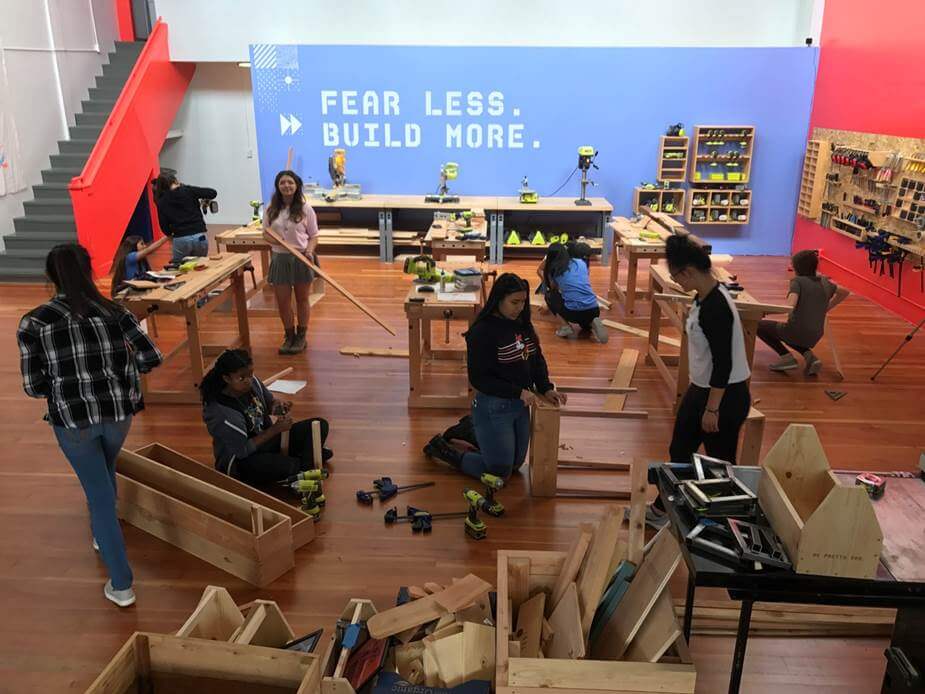 he words FEAR LESS, BUILD MORE are among the first things you see as you step through the entrance of Girls Garage in West Berkeley, California. This powerful statement hangs above you and all those working and learning inside their workshop, like an inspirational mantra that gives both purpose and encouragement.
he words FEAR LESS, BUILD MORE are among the first things you see as you step through the entrance of Girls Garage in West Berkeley, California. This powerful statement hangs above you and all those working and learning inside their workshop, like an inspirational mantra that gives both purpose and encouragement.
Here, girls ages 9 to 17 tackle design and engineering problems while wielding welders and power tools. Working together, the girls take on challenges ranging from metalwork, car repair and carpentry – to building improvements for community organizations such as women’s centers and daycares. Beyond building the solutions themselves, the girls gain a newfound source of confidence and determination.
Launched in 2016, Girls Garage is the latest program from designer Emily Pilloton whose previous work blending design, building, education, and community engagement was featured in the 2013 documentary If You Build It.
At Girls Garage, young women are more than just empowered. In fact, empowerment is one of the last words they might use to describe their impact; the word itself insinuates that power is being given rather than simply assumed. Here, the girls who are creating and building solutions are learning that they control every aspect of their own futures. They discover their own ability to make decisions and learn that a world of opportunities is nothing to be feared, but rather intentionally shaped and pursued.

Teen girls from the Girls Garage summer institute design and build planter boxes for a nearby women’s shelter. Photo provided by Emily Pilloton.
This kind of impact results when an entrepreneur connects the dots between social good and the unique services they can provide. In the case of Emily and her team, it’s about helping young people discover resilience within themselves and strengthen connections with their local communities.
Girls Garage is not selling education. What they offer is transformation for these young girls in how they learn, how they see themselves, and how they engage the world. For entrepreneurs like Emily, transformation may be the embedded secret to success that all businesses can learn from.
A Different Value Exchange
Recently, I spent some time with Jim Gilmore, co-author of the acclaimed business book The Experience Economy. Much of our conversation revolved around an economic theory he calls “The Progression of Economic Value.” It’s a simple construct, where value increases as businesses move along a scale – from offering commodities to offering products, then services, then experiences, and ultimately transformations. It was this last category that reminded me of my experiences engaging with impactful entrepreneurs.
The impact of these businesses is not in the products and services they sell, but in the transformations they instigate. Tweet This Quote
Entrepreneurs who focus on social or environmental issues – whether they realize it or not – are offering an entirely different kind of value exchange. Selling a solar irrigation system to a farmer in Kenya, for instance, has very little to do with positioning the actual product and much more to do with exponentially increasing the nation’s ability to produce its own food. In a similar way, a shop class for girls has less to do with education than it does with creating “FEAR LESS” future leaders.
The impact of these businesses is not in the products and services they sell, but in the transformations they instigate within the communities they serve. That transformation is their offering, and it’s ultimately what their customers are buying.
Offering Transformation
How can we learn from transformative business models from entrepreneurs like this? First, we must identify the outcomes that our products and services ultimately produce. Are these truly impactful and transformative results? If not, how do we make them more impactful? If so, how might we position that result as our offering, as opposed to the product, service, or experience from which it originates?
We should also consider monetizing the transformative result and scaling financial reward depending on the degree of success achieved. Transformative business models interconnect profit with purpose, tying their returns to their impact.
Transformative business models interconnect profit with purpose, tying their returns to their impact. Tweet This Quote
Take for example pay-as-you-go technology company Angaza, which provides clean solar lighting to millions of people. Their approach eliminates the biggest obstacle to these solutions: the high upfront cost of the technology. Angaza provides transformative solutions to their customers by spreading costs out over time and providing life-changing solutions for less than one dollar a week. They are not selling a technology product; they are selling access to clean, affordable, light.
As the leader of an impactful organization, ask yourself or your team the following simple questions as you think about how to position your offering of transformation:
- What is the transformative result we wish to create?
- How valuable is this transformation to our customer?
- Is this transformation a singular event, or is it reoccurring and sustaining?
- Can we measure the result?
- Can we scale the financial return to correspond to the measure of success?
When offering transformation, we should be willing to see our businesses as vehicles of an end as opposed to the means. Helping our customers reach transformative objectives (and holding ourselves accountable for that result) may ultimately be far more valuable then offering tools alone.



